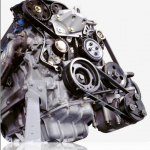Dayco notes the following technical points on the Ford Focus:
Of the numerous variants of the Ford Focus, the 1.4 or 1.6 petrol ‘Zetec/Duratec’ engine has been the power plant for many of the versions sold into the UK since its introduction.
Although the timing drive system for this unit is relatively straightforward, over the years Ford has changed the type of automatic timing tensioner it has used on several occasions. This means that when technicians are undertaking a timing belt replacement they may be faced with a tensioner that requires adjustment from either a hole on the mounting plate, via a cam or, the latest version (OE 1361840), which is free of any setting requirement.
Despite these differences however, Dayco has simplified the replacement process by including tensioner ATB1000 in its timing belt kit KTB286, which provides a single replacement for each and every tensioner previously fitted to the unit. Incidentally, tensioner ATB1000 is exactly the same part as is supplied by Ford as its OES part through its dealers.
Again, the replacement process itself is not a complicated procedure for technicians either, but it is important that it is followed correctly. The new tensioner should be secured into position with the locking pin in place, using the bolts from the original tensioner. These must be tightened to 20Nm and then the locking pin removed. The spring mechanism, which is automatically set to a factory-loaded setting, will then maintain the belt at the correct tension.
The full fitting instructions are available within Dayco Technical Information sheet TI0009EN and on MAM’s Autocat system.
New Opportunities
Although the timing belt replacement for this unit will be a very familiar job for many workshops, it is the front end auxiliary drive (FEAD) system that presents them with a genuinely new revenue opportunity.
Despite being subject to similar mileages to the timing drive system, the FEAD system has not traditionally been subject to any particular maintenance or replacement schedules. However, some vehicle manufacturers are now beginning to introduce FEAD system maintenance into their service schedules, which opens the door for the independent sector to apply similar service principles to the auxiliary belt and the associated component such as tensioners and idlers that together make up the FEAD system.
There are a number of very important reasons why technicians should examine the FEAD system. These include the fact that although the auxiliary belt is not directly a safety critical component, there have been cases where the belt has snapped and has broken a timing belt cover and the debris from that damage has caused the failure of the timing belt.
In addition, as the auxiliary belt in the modern vehicle now drives so many vital components – alternator, power steering pump, air conditioning compressor, vacuum pumps etc. – even if its failure does not directly stop the vehicle, it could certainly leave the driver without power to some parts of the vehicle that could make it in effect, undriveable.
Early examples of the Focus Zetec/Duratec unit had either a single multi-v belt driving the alternator and power steering pump or a single multi-v belt driving the alternator, power steering pump and an air conditioning compressor, both with a tensioner and idler. Later units however have two elastic multi-v belts, one for the water pump, alternator and power steering pump and the other for the air conditioning compressor. These are obviously not fitted with FEAD tensioners or idlers.
However, whatever the age of the unit, the auxiliary belt/belts need to be removed to undertake a timing belt replacement, which makes checking them and replacing if necessary while the system is disassembled, a wise course of action.
Dayco can even provide technicians with a small tool named the ‘a-WEAR-ness gauge’ to carry out three visual checks that will clearly reveal the condition of the belt.
Once this assessment has been made, Dayco can naturally provide the necessary replacement components, which in the case of the elastic belt version is replacement PVE001, which contains both of the auxiliary belts for this unit or PVE002, which is for the water pump, alternator and power steering pump only. Either replacement includes the necessary fitting tools to correctly install these items.
However, for units up to August 2001 without air conditioning the required components are belt 6PK1740 with tensioner APV2314 and idler APV2815. For units with air conditioning the belt required is 6PK1890 with tensioner APV2268 and idler APV2815. This was superseded in March 2002 with belt 6PK1915, but retained tensioner APV2268 and idler APV2815, which remained until the elastic belt drive system was introduced.










Go to comments